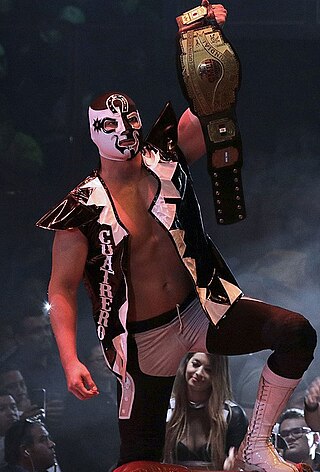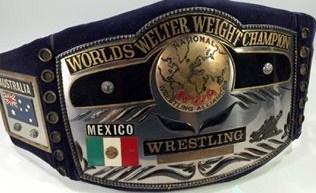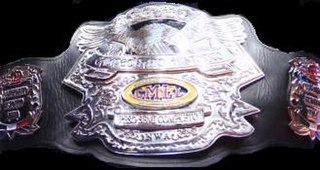Related Research Articles
Roberto Gutiérrez Frías is a Mexican retired professional wrestler and wrestling trainer, best known under the ring name El Dandy. He is the cousin of professional wrestler Juan Conrado Aguilar, known as El Texano, and the uncle of Aguilar's sons, who wrestle as El Texano Jr. and Súper Nova. While he had a retirement tour in 2014, Gutiérrez has wrestled most recently in March 2019. Gutiérrez has wrestled for most major Mexican promotions, including Consejo Mundial de Lucha Libre, Lucha Libre AAA Worldwide, Universal Wrestling Association, World Wrestling Association, and International Wrestling Revolution Group. In addition, he has worked for the US-based World Championship Wrestling as well as the Japanese Super World Sports and the International Wrestling Association of Japan.
The NWA World Middleweight Championship was a professional wrestling championship in the National Wrestling Alliance (NWA) between 1939 and 2010. For most of its existence, it was defended in the Mexican lucha libre promotion Consejo Mundial de Lucha Libre (CMLL), who called it the Campeonato Mundial Peso Medio de NWA. As it is a professional wrestling championship, its holders were determined by promoters or promotions, not by athletic competition. The official middleweight limits in lucha libre are 82 kg (181 lb) to 87 kg (192 lb), but this rule is broken when convenient.

The CMLL World Middleweight Championship is a professional wrestling world championship promoted by the Mexican wrestling promotion Consejo Mundial de Lucha Libre (CMLL). While lighter weight classes are regularly ignored in wrestling promotions in the United States, with most emphasis placed on "heavyweights", more emphasis is placed on the lighter classes in Mexican companies. The official definition of the middleweight division in Mexico is a person between 82 kg (181 lb) and 87 kg (192 lb), but the weight limits are not strictly adhered to. As it is a professional wrestling championship, it is not won via legitimate competition; it is instead won via a scripted ending to a match or on occasion awarded to a wrestler because of a storyline.

The NWA World Welterweight Championship is an inactive professional wrestling championship governed by the National Wrestling Alliance (NWA) and most recently promoted by NWA Mexico. The championship was originally created in 1946 by the Mexican promotion Consejo Mundial de Lucha Libre (CMLL). As with all professional wrestling championships, matches for the NWA World Welterweight Championship were not won or lost competitively but by a pre-planned ending to a match, with the outcome determined by the CMLL bookers and match makers. CMLL controlled the championship from 1946 until 1996 and again from 2007 until 2010. From 1996 until 2007 the championship was promoted mainly in Japan, initially as one of eight championships that made up the New Japan Pro-Wrestling (NJPW) J-Crown Championship. After the J-Crown was discontinued the title remained in Japan promoted by the Toryumon federation until 2007 when it returned to Mexico and CMLL. CMLL was a member of the National Wrestling Alliance (NWA) until the late 1980s but chose to keep the championship and the NWA prefix after leaving the NWA.

The CMLL World Lightweight Championship is a professional wrestling world championship promoted by the Consejo Mundial de Lucha Libre (CMLL), a Mexican Lucha Libre wrestling promotion (franchise). Originally, CMLL promoted the "Super Lightweight" division as part of their expansion into Japan in 1999 and 2000 and later reintroduced the division in 2003, at the same time they were running a CMLL World Super Lightweight Championship in Mexico. During Máscara Dorada's reign between 2009 and 2011, the name was changed to the CMLL Lightweight Championship, adjusting the weight limit.
The Mexican National Middleweight Championship(Campeonato Nacional de Peso Medio) is a professional wrestling championship controlled by the Comisión de Box y Lucha Libre Mexico D.F.. The official weight definition of the middleweight division in Mexico is from 82 to 87 kg. The championship was created in 1933 and was promoted regularly until December 8, 2008. Empresa Mexicana de Lucha Libre (EMLL) had control of the championship from its creation until 1992, at which point it was transferred to Lucha Libre AAA Worldwide (AAA). The championship's history between 1933 and 1937 is only partially known; for some periods it is unclear who held the championship. The first champion was Yaqui Joe; records of the identity of his opponent for the championship are unclear. In early 2009, AAA stopped promoting all Mexican National Championships, opting to focus on its AAA-branded championships instead. In 2021, the championship was reactivated by Consejo Mundial de Lucha Libre, with Templario defeating Dragón Rojo Jr. to win the vacant title.
Daniel López López is a Mexican luchador and trainer, best known under the ring name El Satánico. He was originally an enmascarado, but lost the mask early in his career and has performed unmasked ever since. The majority of his in-ring career was spent in Consejo Mundial de Lucha Libre (CMLL), where he worked as a rudo.

Sergio Emilio Charles Garduño was a Mexican luchador, who is best known under the ring name Emilio Charles Jr. Over the years, Charles worked for all of the major Mexican professional wrestling promotions, including Consejo Mundial de Lucha Libre (CMLL), Asistencia Asesoría y Administración and International Wrestling Revolution Group.
Genaro Jacobo Contreras, better known by his ring name Ringo Mendoza, a Mexican professional wrestling trainer and retired luchador for Consejo Mundial de Lucha Libre (CMLL). Mendoza wrestled his last match in 2011, transitioning to being a full-time trainer instead.

Homenaje a Dos Leyendas (2006) was a professional wrestling supercard show event, scripted and produced by Consejo Mundial de Lucha Libre. The Dos Leyendas show took place on March 17, 2006 in CMLL's main venue, Arena México, Mexico City, Mexico. The event was to honor and remember CMLL founder Salvador Lutteroth, who died in March 1987. Starting in 1999 CMLL honored not just their founder, but also El Santo, the most famous Mexican professional wrestler ever. This was the seventh March show held under the Homenaje a Dos Leyendas name, having previously been known as Homenaje a Salvador Lutteroth from 1996 to 1998.

The NWA World Historic Middleweight Championship is a professional wrestling championship promoted by Consejo Mundial de Lucha Libre (CMLL). The official definition of the middleweight weight class in Mexico is between 82 kg (181 lb) and 87 kg (192 lb), but is not always strictly enforced. For example, previous NWA World Historic Middleweight Champion Último Guerrero is billed as weighing 95 kg (209 lb). Místico is the current champion, he is the eighth champion overall and he is in his first reign.

Homenaje a Dos Leyendas (2011) was a professional wrestling supercard show event, scripted and produced by Consejo Mundial de Lucha Libre. The Dos Leyendas show took place on March 18, 2011 in CMLL's main venue, Arena México, Mexico City, Mexico. The event was to honor and remember CMLL founder Salvador Lutteroth, who died in March 1987. Starting in 1999 CMLL honored not just their founder during the show, but also a second lucha libre legend, making it their version of a Hall of Fame event. For the 2011 show CMLL commemorated the life and career of wrestler Ángel Blanco, grandfather of then-CMLL wrestler Höruz. This was the 13th March show held under the Homenaje a Dos Leyendas name, having previously been known as Homenaje a Salvador Lutteroth from 1996 to 1998.

Homenaje a Dos Leyendas: El Santo y Salvador Lutteroth (2003) was a professional wrestling supercard show event, scripted and produced by Consejo Mundial de Lucha Libre. The Dos Leyendas show took place on March 21, 2003 in CMLL's main venue, Arena México, Mexico City, Mexico. The event was to honor and remember CMLL founder Salvador Lutteroth, who died in March 1987. This was fifth March show held under the Homenaje a Dos Leyendas name, having previously been known as Homenaje a Salvador Lutteroth. Starting in 1999 CMLL honored not just their founder, but also El Santo, the most famous Mexican professional wrestler ever. The name of the annual March event would later be shortened to just Homenaje a Dos Leyendas after CMLL had a falling out with El Santo's son El Hijo del Santo, with the event honoring a different wrestler along with Lutteroth.
The EMLL 28th Anniversary Show was a professional wrestling major show event produced by Empresa Mexicana de Lucha Libre (EMLL) that took place on September 22, 1961, in Arena México, Mexico City, Mexico. The event commemorated the 28th anniversary of EMLL, which became the oldest professional wrestling promotion in the world. The Anniversary show is EMLL's biggest show of the year. The EMLL Anniversary Show series is the longest-running annual professional wrestling show, starting in 1934.
The 'EMLL 36th Anniversary Show ' was a professional wrestling major show event produced by Empresa Mexicana de Lucha Libre (EMLL) that took place on August 15, 1969 in Arena México, Mexico City, Mexico. It commemorated the 36th anniversary of EMLL, which would become the oldest professional wrestling promotion in the world. It is EMLL's biggest show of the year, and the longest-running annual professional wrestling show, having started in 1934.

Homenaje a Dos Leyendas (2014) was a professional wrestling supercard show event, scripted and produced by Consejo Mundial de Lucha Libre. The Dos Leyendas show took place on March 21, 2014 in CMLL's main venue, Arena México, Mexico City, Mexico. The event was to honor and remember CMLL founder Salvador Lutteroth, who died in March 1987. Starting in 1999 CMLL honored not just their founder during the show, but also a second lucha libre legend, making it their version of a Hall of Fame event. For the 2014 show CMLL commemorated the life and career of wrestler and lucha film star Rayo de Jalisco Sr. This was the 16th March show held under the Homenaje a Dos Leyendas name, having previously been known as Homenaje a Salvador Lutteroth from 1996 to 1998.

Homenaje a Dos Leyendas (2016) was a professional wrestling pay-per-view show event, scripted and produced by Consejo Mundial de Lucha Libre. The Dos Leyendas show took place on March 18, 2016 in CMLL's main venue, Arena México, Mexico City, Mexico. The event was to honor and remember CMLL founder Salvador Lutteroth, who died in March 1987. Starting in 1999 CMLL honored not just their founder during the show, but also a second lucha libre legend, making it their version of a Hall of Fame event. For the 2016 show CMLL commemorated the life and career of wrestler Lizmark. This was the 18th March show held under the Homenaje a Dos Leyendas name, having previously been known as Homenaje a Salvador Lutteroth from 1996 to 1998.
1965 in professional wrestling describes the year's events in the world of professional wrestling.
1968 in professional wrestling describes the year's events in the world of professional wrestling.

The CMLL Japan Women's Championship, also known as the CMLL Japanese Women's Championship, is a women's professional wrestling championship, promoted by the Mexican lucha libre promotion Consejo Mundial de Lucha Libre (CMLL) and Japanese joshi puroresu promotion Lady's Ring. Dark Silueta is the current champion, the fifth overall champion and the second since the championship was reactivated in 2020. Silueta won the championship on September 17, 2023, when she defeated Kohakuin to win the title.
References
- Hornbaker, Tim (2016). "Statistical notes". Legends of Pro Wrestling – 150 years of headlocks, body slams, and piledrivers (Revised ed.). New York, New York: Sports Publishing. ISBN 978-1-61321-808-2.
- Duncan, Royal; Will, Gary (2000). Wrestling title histories: professional wrestling champions around the world from the 19th century to the present. Waterloo, ON: Archeus Communications. ISBN 0-9698161-5-4.
- Montiel Rojas, Arturo (August 30, 2001). "Reglamento de Box y Lucha Libre Profesional del Estado de México" (PDF) (in Spanish). Comisión de Box y Lucha Libre Mexico D.F. Archived from the original (PDF) on November 30, 2006. Retrieved January 9, 2020.
- ↑ Hornbaker 2016, p. 550.
- ↑ Duncan & Will 2000, p. 271.
- ↑ Duncan & Will 2000, p. 20.
- ↑ Duncan & Will 2000, p. 201.
- 1 2 3 4 Duncan & Will 2000, p. 392.
- ↑ Duncan & Will 2000, pp. 389–390.
- 1 2 3 4 5 6 Boutwell, Josh (August 20, 2010). "Viva La Raza! Lucha Weekly". WrestleView. Archived from the original on September 26, 2010. Retrieved June 26, 2011.
- 1 2 3 4 5 Duncan & Will 2000, p. 390.
- 1 2 3 4 5 6 7 Duncan & Will 2000, p. 389.
- 1 2 "Arena Coliseo". Lucha Libre (in Spanish). No. 165. December 29, 1966. p. 11.
- 1 2 "Arena Mexico". Lucha Libre (in Spanish). No. 259. September 27, 1968. p. 12.
- 1 2 3 4 5 6 7 8 9 10 11 Duncan & Will 2000, p. 388.
- 1 2 3 4 5 6 "2000 Especial!" [2000 Special!]. Box y Lucha Magazine (in Spanish). January 9, 2001. p. 19. issue 2488.
- 1 2 Acosa, Robero (December 20, 2009). "Resultados Arena Monterrey "Primer Campeón Azteca" 19/Dic/2009" [Arena Monterrey Results, "First Aztec Champion December 19, 2009] (in Spanish). Estrellas del Ring. Retrieved February 24, 2019.
- 1 2 "Lucha Libre Azteca (LLA) >> Results". CageMatch. Retrieved February 2, 2019.
- 1 2 3 Montiel Rojas 2001, p. 23.
- ↑ Duncan & Will 2000, p. 395.
- ↑ "Número Especial – Lo mejor de la lucha libre mexicana durante el 2004" [Special Edition – the best of Mexican professional wrestling during 2004]. Súper Luchas (in Spanish). January 24, 2005. 91.
- ↑ "J-CROWN Octuple Title Unification Tournament". Wrestling-Titles. Retrieved January 9, 2020.
- ↑ Ocampo, Ernesto, ed. (December 26, 2007). "2007 Lo Mejor de la Lucha Mexicana" [2007 the best of Mexican wrestling]. Súper Luchas (in Spanish). Mexico City, Mexico: Impresos Camsam, SA de CV. ISSN 1665-8876. issue 244. Retrieved July 11, 2009.
- ↑ Duncan & Will 2000, p. 397.
- ↑ "Arena Coliseo". Lucha Libre (in Spanish). No. 220. December 16, 1967. p. 11.
- ↑ "NWA Intercontinental Heavyweight Title". Wrestling-Titles. Retrieved January 8, 2020.
- ↑ "UWA". CageMatch. September 13, 1990. Retrieved May 13, 2020.
- ↑ Duncan & Will 2000, p. 391.
- ↑ "CMLL Japan Women's Championship >> 25.11.1999 – 08.06.2001: Chikako Shiratori (2)". CageMatch. Retrieved January 10, 2020.
- ↑ "CMLL Japan Super Lightweight Championship > Title Reigns > 06.08.2000 – xx.xx.2000: Ricky Marvin". CageMatch. Retrieved June 3, 2017.
- ↑ "CMLL Japan Super Lightweight Championship > Title Reigns > xx.xx.2000 – 29.11.2000: Virus (2)". CageMatch. Retrieved June 3, 2017.
- ↑ Meltzer, Dave (November 29, 2015). "Daily Update: Matt Hardy hospitalized, Santio married". Figure Four Wrestling Observer Online . Retrieved May 31, 2017.
- 1 2 Dragon Lee (March 11, 2017). "#Dragonlee (See details in picture posted)" (in Spanish). Twitter . Retrieved March 16, 2017.
- ↑ "CMLL Japan Tag Team Championship >> 24.02.1999 – 02.07.1999 Tsubasa & El Oriental". CageMatch. Retrieved January 9, 2020.
- ↑ "CMLL Japan Tag Team Championship >> 02.07.1999 – 26.09.2000: Masato Yakushiji & Naohiro Hoshikawa". CageMatch. Retrieved January 9, 2020.
- ↑ "Azteca Championship >> 19.12.2009 – 10.08.2010: Ultimo Guerrero". CageMatch. Retrieved February 2, 2019.
- ↑ Arrandondo, Angel (May 5, 2014). "Resultados Lucha Libre Azteca – Gimnasio Nuevo León – Domingo 04 Mayo 2014" [Lucha Libre Azteca results – Gymnasium Nuevo Leon – Sunday May 4, 2014]. Luchamania Monterrey (in Spanish). Retrieved February 2, 2019.
- ↑ "Azteca Championship >> 04.05.2014 – today: Atlantis (2)". CageMatch. Retrieved February 2, 2019.